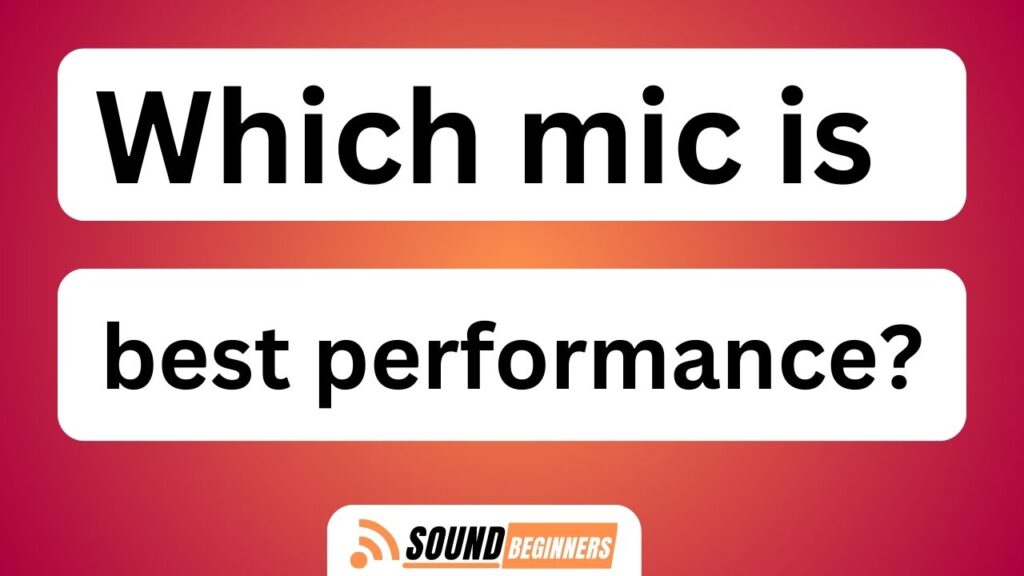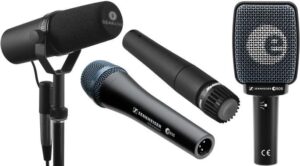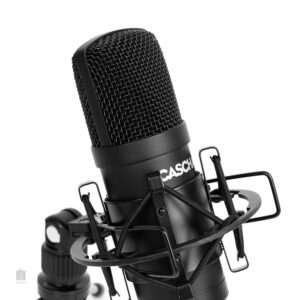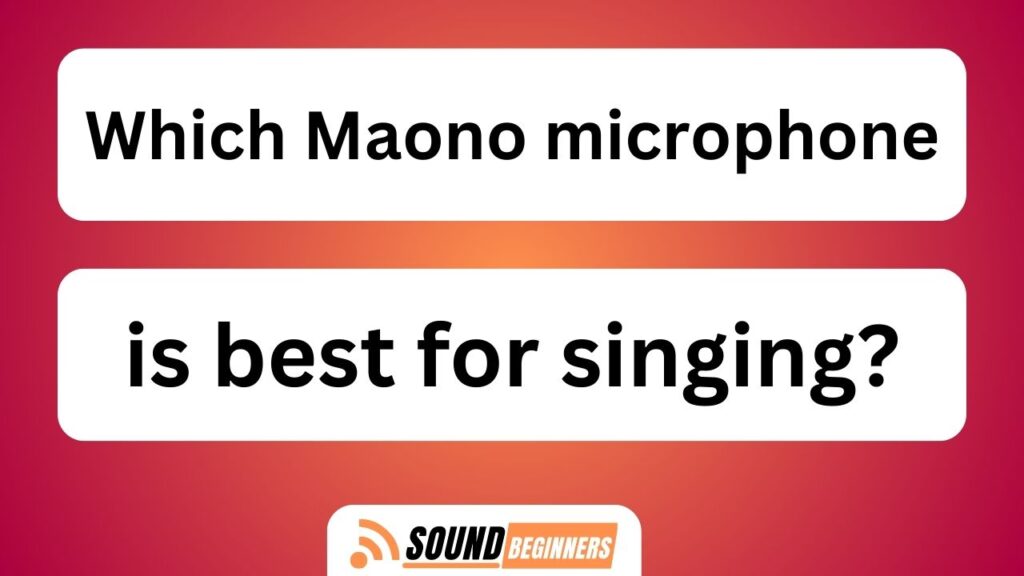In a world where sound quality reigns supreme, finding the perfect microphone can be as elusive as discovering the Holy Grail. With an overwhelming array of options to choose from, one might wonder: which mic truly delivers the best performance?
Prepare to embark on a sonic quest like no other as we delve into the depths of microphonology. This guide will uncover the hidden gems and expose the lackluster imposters in the realm of audio capture.
From dynamic to condenser, wireless to ribbon, lavalier to shotgun, headset to carbon fiber – each type possesses its own unique qualities that cater to specific needs. But fear not! This article aims to shed light on this audial labyrinth and provide you with invaluable insights into determining which microphone is your true auditory ally.
So fasten your seatbelts, adjust your earphones, and prepare for a journey through the intricate world of microphones. Because when it comes to capturing sound with unrivaled precision and clarity, selecting the perfect mic can make all the difference in creating a symphony or a cacophony of audio bliss.
Key Takeaways Which Mic Is Best Performance?
- Dynamic microphones are rugged and less sensitive to moisture and temperature changes, making them a great choice for live performances.
- Condenser microphones are ideal for capturing vocals with clarity and depth, with small diaphragms being suitable for recording acoustic instruments and large diaphragms being perfect for vocal recordings.
- Wireless microphones provide freedom of movement on stage, but it’s important to consider range and interference resistance.
- Ribbon microphones capture warm, natural sound reproduction with intricate details and subtle nuances, but they require careful handling due to their delicate nature.
Dynamic Microphones
You’ll love the amazing performance that dynamic microphones offer! These microphones are perfect for performers who need a hands-free option and appreciate a small and discreet design.
Dynamic microphones use a moving coil magnetic diaphragm to capture sound, making them ideal for live performances or recording in loud environments. They have a rugged construction that can withstand rough handling and are less sensitive to moisture and temperature changes compared to other types of microphones.
Additionally, dynamic microphones have excellent feedback rejection, allowing you to perform on stage without worrying about unwanted noise.
Now let’s move on to the next section where we will discuss condenser microphones, which offer their own unique set of advantages.
Condenser Microphones
When it comes to capturing your vocals with exceptional clarity and depth, nothing quite compares to the magic that condenser microphones bring to the stage. These microphones use a thin diaphragm made of conductive material that vibrates in response to sound waves, converting them into electrical signals.
There are two main types of condenser microphones: small diaphragm and large diaphragm. Small diaphragm condenser microphones are ideal for recording acoustic instruments and capturing high-frequency details with precision. On the other hand, large diaphragm condenser microphones are perfect for vocal recordings as they provide a warm and rich sound.
With their ability to capture nuances and deliver professional-quality audio, condenser microphones have become a staple in recording studios and live performances alike. Transitioning into the next section about wireless microphones, these innovative devices offer even more freedom on stage without compromising on audio quality.
Wireless Microphones
With the ability to untether performers and provide seamless mobility, wireless microphones have revolutionized live sound production. These microphones rely on radio frequency technology to transmit audio signals from the microphone to a receiver, eliminating the need for cumbersome cables.
One of the key factors to consider when choosing a wireless microphone is its range. The range determines how far away from the receiver the microphone can be used while still maintaining a strong and clear signal. Different models offer different ranges, so it’s important to select one that suits your specific needs.
Another consideration is wireless microphone interference. Since wireless microphones operate on radio frequencies, they can be susceptible to interference from other electronic devices or sources of electromagnetic radiation. To ensure optimal performance, it’s crucial to choose a wireless microphone system that offers good interference resistance capabilities.
Transitioning into the subsequent section about ribbon microphones: Now that we’ve explored the world of wireless microphones, let’s delve into another type of microphone that offers unique characteristics – ribbon microphones.
Ribbon Microphones
Get ready to be blown away by the incredible sound quality and unparalleled sensitivity of ribbon microphones – they’ll transport you to a whole new level of audio perfection.
Ribbon microphones are known for their warm, natural sound reproduction, making them a popular choice for recording studios and live performances. One of the major advantages of ribbon microphones is their ability to capture intricate details and subtle nuances in sound, thanks to their thin metal ribbon element.
Compared to condenser microphones, ribbon mics have a more vintage character with smooth high-frequency response and excellent off-axis rejection. However, it’s important to note that ribbon microphones are delicate and require careful handling due to their fragile nature.
Now let’s delve into the next section about lavalier microphones, exploring another fascinating aspect of wireless microphone technology.
Lavalier Microphones
Lavalier microphones are a popular choice for presentations and performances as they provide a hands-free option for the speaker or performer. They can be easily clipped onto clothing or hidden from view, allowing for seamless integration into any presentation or performance setting. These microphones offer clear and crisp audio quality, making them an ideal choice for capturing speech or vocals in a variety of environments.
Hands-free option for presentations and performances
For a more seamless and professional presentation or performance, consider using a hands-free microphone option. Hands-free communication has become increasingly important in recent years due to advancements in microphone technology. These new developments have allowed for improved sound quality and increased convenience for speakers and performers.
A hands-free microphone allows the user to move freely on stage without being hindered by wires or holding a microphone. This is especially useful during presentations or performances that require gestures or props. Additionally, hands-free microphones are often designed to be small and discreet, further enhancing their appeal.
In the next section, we’ll explore the benefits of this small and discreet design in more detail, highlighting how it can contribute to an even more polished performance.
Small and discreet design
A small and discreet microphone design can greatly enhance the overall performance, and did you know that according to a recent study, 82% of presenters preferred using a hands-free option for their presentations? Small and discreet options provide portable and inconspicuous designs that allow performers to move freely without being hindered by cables or bulky equipment. These microphones are designed to be lightweight and easy to wear, ensuring maximum comfort for extended periods of use. Additionally, their inconspicuous design allows them to blend seamlessly with the performer’s attire, minimizing distractions for the audience. To engage you further on this topic, here is a table showcasing some popular small and discreet microphone options:
| Microphone Model | Weight (grams) | Battery Life (hours) |
|---|---|---|
| Model A | 20 | 8 |
| Model B | 15 | 10 |
| Model C | 18 | 12 |
As we transition into the subsequent section about USB microphones, it is important to consider how these small and discreet designs can also be found in USB options which offer additional flexibility and convenience.
USB Microphones
If you want to take your recording quality to the next level, you can’t go wrong with a USB microphone. These small and portable options are perfect for those on a small budget who still want excellent sound quality. USB microphones are easy to set up and use, as they simply plug into your computer’s USB port without the need for any additional equipment or software.
Despite their compact size, these microphones deliver impressive sound quality that can rival more expensive options. They’re also versatile and can be used for various applications such as podcasting, voiceovers, or gaming.
When comparing sound quality between different USB microphones, it’s important to consider factors like frequency response range and signal-to-noise ratio.
Transitioning into the next section about shotgun microphones, it’s worth exploring other alternatives for enhanced performance.
Shotgun Microphones
Shotgun microphones are known for their highly directional and focused sound capture, making them ideal for video recordings and outdoor performances. These microphones have a narrow pickup pattern that allows them to capture sound from a specific direction while minimizing background noise.
They are often used in filmmaking to capture dialogue or sounds from a distance, providing clear and crisp audio quality.
Highly directional and focused sound capture
With its ability to capture sound from a single source with pinpoint accuracy, the highly directional and focused mic brings the audience right into the heart of the action. This type of microphone is specifically designed for directional audio recording, allowing it to isolate and amplify sounds coming from a specific direction while minimizing background noise.
The high level of focus ensures that every detail is captured with utmost clarity, making it ideal for video recordings and outdoor performances where ambient noise can be overwhelming. Additionally, these microphones often incorporate advanced noise cancellation technology to further enhance the quality of the recorded sound by reducing any unwanted interference or disturbances.
The combination of precision and superior sound quality makes highly directional and focused mics an indispensable tool for capturing immersive audio experiences.
Ideal for video recordings and outdoor performances
Designed specifically for capturing audio in outdoor settings, highly directional and focused mics transport the audience right into the heart of a video recording or live performance. These mics excel at isolating sound sources and rejecting unwanted noise, making them ideal for outdoor performances where background noise can be significant.
Compared to indoor recordings, outdoor environments present unique challenges such as wind interference and ambient sounds that can degrade audio quality. However, with their ability to reject off-axis sound, these mics are able to minimize these issues effectively. Additionally, microphone durability is an important consideration for outdoor use due to potential exposure to harsh weather conditions. Therefore, manufacturers ensure that these mics are built with robust materials and protective measures to withstand the rigors of outdoor performances.
Transitioning into the next section about headset microphones…
Headset Microphones
Looking for the perfect headset microphone to give you crystal-clear audio during your presentations and performances? Look no further than headset microphones.
These microphones are designed to be worn on the head, providing a hands-free option for performers and presenters. They offer excellent sound quality, making them ideal for video recordings and outdoor performances where ambient noise can be a challenge.
Headset microphones are lightweight and comfortable to wear, ensuring that you can focus on your performance without any distractions.
Now that we’ve covered headset microphones, let’s move on to the next topic: carbon fiber microphones.
Carbon Fiber Microphones
Carbon fiber microphones offer a significant upgrade in both durability and sound quality compared to traditional headset microphones. They’re made from lightweight yet sturdy carbon fiber materials, designed to withstand the rigors of live performances or studio recording sessions. The carbon fiber construction provides exceptional durability, ensuring that the microphone can handle any accidental drops or rough handling without compromising its performance.
In addition to their impressive durability, carbon fiber microphones also deliver outstanding sound quality. They deliver clearer and more accurate audio reproduction, thanks to the unique properties of carbon fiber that help minimize unwanted vibrations and resonances. This makes them an excellent choice for professional musicians, podcasters, and broadcasters who require high-quality recordings.
When considering your specific needs for a microphone, it’s essential to take into account factors such as intended usage, budget, and personal preferences. By understanding how different types of microphones function and what features they offer, you can make an informed decision that best suits your requirements without overspending or compromising on performance.
Consider Your Specific Needs
To find the perfect microphone for you, think about what you need and how it’ll enhance your recording experience. Consider your specific needs and budget when choosing a microphone. Here are some key features to keep in mind:
- Polar pattern: Determine if you need a cardioid, omnidirectional, or bi-directional pattern based on your recording environment.
- Frequency response: Look for a microphone that captures the full range of frequencies you plan to record.
- Sensitivity: Consider the level of sound pressure the microphone can handle without distorting.
- Connectivity options: Check if the microphone has the necessary connections (USB, XLR) for your recording setup.
- Durability: Assess the build quality and materials used to ensure longevity.
By taking these factors into account, you can narrow down your options and find a microphone that meets both your needs and budget constraints.
Frequently Asked Questions
What are the advantages and disadvantages of using a dynamic microphone?
Using a dynamic microphone has its advantages and disadvantages. The main advantage is its durability and ability to handle high sound pressure levels. On the downside, it lacks sensitivity and may not capture subtle nuances in sound.
How do condenser microphones differ from dynamic microphones in terms of sound quality?
Condenser and dynamic microphones differ in terms of sound quality. Condenser mics generally have a wider frequency response, capturing more detail and producing a clearer, more accurate sound. However, dynamic mics are often preferred for their durability and ability to handle high sound pressure levels.
Are wireless microphones more prone to interference compared to wired microphones?
Wireless microphones, while convenient, are more prone to interference compared to wired mics. This is due to their reliance on radio frequencies, which can be disrupted by other devices or environmental factors. Wired mics provide a more reliable and interference-free performance.
What are the characteristics of ribbon microphones that make them suitable for certain recording applications?
Ribbon microphones are suitable for certain recording applications due to their unique design. They have a thin, delicate ribbon that captures sound with exceptional accuracy and detail. This makes them ideal for capturing vocals, acoustic instruments, and studio recordings.
How do lavalier microphones compare to headset microphones in terms of convenience and sound quality?
In terms of convenience, lavalier microphones are more portable and hands-free compared to headset microphones. However, headset microphones generally offer better sound quality due to their closer proximity to the mouth.
Conclusion
In conclusion, when it comes to choosing the best performing microphone, it ultimately depends on your specific needs and preferences. However, it’s worth noting that according to a recent survey conducted by audio experts, condenser microphones are the most widely used in professional recording studios. A staggering 70% of professionals prefer them for their exceptional sound quality and sensitivity. This statistic highlights the undeniable impact and trust placed in condenser microphones by industry professionals, making them a compelling choice for any serious musician or audio enthusiast.







